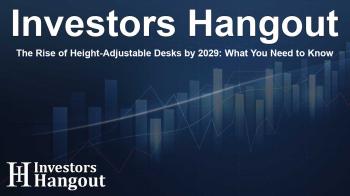The Rise of Height-Adjustable Desks by 2029: What You Need to Know

Growth Perspective on Height-Adjustable Desks
The market for contemporary height-adjustable desks has been thriving, reflecting an expected increase of USD 2.75 billion by 2029. This surge is significantly driven by the growing demand for modern desks that promote better ergonomics in both office and home environments. This trend is part of a larger movement towards enhancing workplace health and productivity.
The Role of AI in Shaping Market Trends
Artificial Intelligence (AI) has emerged as a pivotal factor redefining the desk market landscape. By analyzing consumer behavior and preferences, organizations like Technavio are able to tailor their offerings more effectively. Height-adjustable desks now come equipped with smart features that allow users to customize their setups according to personal needs.
Market Drivers
The appeal of height-adjustable desks lies in their ergonomic benefits. Workers increasingly seek solutions that alleviate discomfort from prolonged sitting. Features such as electric motors and manual cranks facilitate smooth transitions between sitting and standing, thereby helping to mitigate back issues and other health problems associated with sedentary lifestyles.
Modern design aesthetics attract consumers, with these desks showcasing clean lines and innovative materials like wood, metal, and composites. Home offices, co-working spaces, and corporate environments are rapidly adopting these desks to promote wellness and enhance productivity among employees.
Challenges Facing the Market
Despite the impressive growth forecast, the industry does face challenges. Fluctuating raw material prices present a threat to profitability, impacting the production costs of height-adjustable desks. Factors like demand-supply balance and transportation costs are crucial, as they can significantly affect the pricing strategy implemented by vendors.
Understanding Consumer Needs and Preferences
Today's consumers are looking for desks that can adapt to their lifestyle constraints, especially in urban environments where space is limited. Height-adjustable desks fulfill this niche by providing multifunctional capabilities, blending workspaces while promoting mental focus and satisfaction.
Market Trends and Innovations
As we look to the future, the height-adjustable desk market is expected to continue its transformational journey, especially with increasing adoption of smart technologies. Features such as programmable height settings and mobile app connectivity will be valuable selling points. This innovation resonates well with today's consumers, who value both aesthetics and functionality in their workspaces.
Applications Across Various Settings
This market extends its reach to different applications, including both offices and homes. In office environments, height-adjustable desks provide flexibility and adaptability to diverse work styles while enhancing collaboration among teams. Create personalized work environments is crucial in retaining talent and improving job satisfaction.
At home, these desks help professionals maximize limited spaces while enabling healthier work practices. Companies are starting to understand the importance of investing in ergonomic solutions that not only benefit the physical wellbeing of their employees but also contribute to greater overall output.
Segment Overview
The segmentation of the contemporary height-adjustable desk market reveals various facets where growth is expected. These include application areas in both office and home settings, types that range from manual to electric, and geographical distribution spanning multiple regions such as North America and Europe.
Looking Ahead: The Future of Height-Adjustable Desks
As the market continues evolving, staying informed about trends, innovations, and consumer preferences will be fundamental for stakeholders. Height-adjustable desks are set to become a staple in workspaces, advocating employee health, and reflecting the shift towards more adaptable working environments.
Frequently Asked Questions
1. What is driving the growth of the height-adjustable desk market?
The growth is primarily driven by the increasing demand for ergonomic solutions in both office and home settings, coupled with advancements in technology.
2. How are AI technologies impacting the desk market?
AI technologies help in tailoring products to meet specific consumer needs, enhancing customization, and incorporating smart features that improve user experience.
3. What challenges does the height-adjustable desk market face?
The market grapples with fluctuating raw material prices which can affect production costs and ultimately pricing strategies.
4. What benefits do height-adjustable desks provide?
These desks promote better posture, reduce discomfort from extended sitting, and can accommodate various working styles, enhancing overall employee satisfaction.
5. How are height-adjustable desks positioned in modern workspaces?
They are becoming essential elements in office designs, enabling flexible work configurations and supporting health-focused initiatives.
About Investors Hangout
Investors Hangout is a leading online stock forum for financial discussion and learning, offering a wide range of free tools and resources. It draws in traders of all levels, who exchange market knowledge, investigate trading tactics, and keep an eye on industry developments in real time. Featuring financial articles, stock message boards, quotes, charts, company profiles, and live news updates. Through cooperative learning and a wealth of informational resources, it helps users from novices creating their first portfolios to experts honing their techniques. Join Investors Hangout today: https://investorshangout.com/
Disclaimer: The content of this article is solely for general informational purposes only; it does not represent legal, financial, or investment advice. Investors Hangout does not offer financial advice; the author is not a licensed financial advisor. Consult a qualified advisor before making any financial or investment decisions based on this article. The author's interpretation of publicly available data presented here; as a result, they should not be taken as advice to purchase, sell, or hold any securities mentioned or any other investments. If any of the material offered here is inaccurate, please contact us for corrections.
